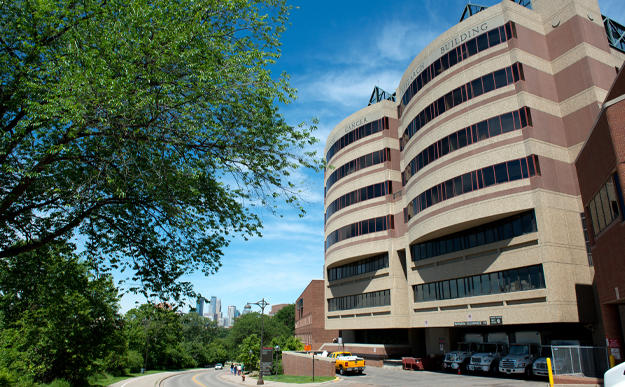Celebrating 30 years of the Masonic Cancer Center

2021 marks thirty years of research, collaboration, and advocacy for the Masonic Cancer Center at the University of Minnesota, and the School of Dentistry has been a part of its research mission every step of the way.
Founded in August of 1991 via a proclamation from then-Governor Anne Carlson, the Masonic Cancer Center “has served as the hub for groundbreaking cancer research at the University of Minnesota,” according to a press release from the Center.
The Center focuses on research exploring the causes, prevention, detection, and treatment of cancer, as well as providing care to patients and sharing knowledge with the greater community. Its six research programs form interdisciplinary teams of scientists who are driven to discover more about the disease. Programs focus on carcinogenesis and chemoprevention; cellular mechanisms; genetic mechanisms; immunology; screening, prevention, etiology and survivorship; and transplant and cellular therapy.
Among the ranks of notable investigators of the past thirty years of cancer discovery are several School of Dentistry experts. Ten faculty members have partnered with the center, with some collaborations dating back as far as 1994 and some as recent as 2019. No matter the length of their time with the center, they agree that the interprofessional nature of the center allows for greater discovery that impacts community health.
Mark Herzberg, DDS, PhD, began his journey with the Cancer Center after a surprising discovery in his lab fifteen years ago: a naturally-occurring antimicrobial protein that, when put into a cancer cell to replace the missing protein, made those cells resistant to bacterial invasion as hypothesized. Remarkably, the transfected cells also took on a more normal phenotype.
He took the discovery to his Dean at the time, Peter Polverini. Polverini, a cancer biologist by training, was struck by the observation and suggested that Herzberg get involved with the Cancer Center to study the phenomenon further. “Whenever I could, I attended seminars,” he explained. “I just began to listen and learn the vocabulary and paradigms, learn a bit about methods—and now, we have an active line of investigation in cancer, centered around this protein.”
For Herzberg, the Center started as a place to learn about a field in which he had little training, and over time became a space for collaboration between and across specialties on projects relating to proteins and immune response. “That is what a center should be,” he explained. “I learn of opportunities that might not be obvious, I seek the counsel of people I meet through the center, and I take advantage of the facilities for my research.” He sees the ways the Cancer Center allowed him to learn about a topic that led to groundbreaking discoveries in the detection and treatment of cancer.
“I don’t think it’s difficult to imagine that without the center, my entry into cancer research would have been a non-starter.”
Nelson Rhodus, DMD, MPH, director of the Division of Oral Medicine, Diagnosis and Radiology, agreed. “The Cancer Center gave me an incentive and a platform for patient care and research,” Rhodus, who joined the Center in 1996, explained. “It gave me an avenue to fully explore and utilize my knowledge.”
Rhodus became involved with the Cancer Center when the head of the Ear, Nose, and Throat department at the University, George Adams, MD, invited him to help treat patients with mouth sores and other ailments resulting from radiation treatment. Over time, he began to partner with other researchers to study the mechanisms of oral cancer. “I learned a lot, and actually became more engaged with the medical school during that time,” he explained.
Today, Rhodus continues to collaborate on research projects, is involved in public health outreach and screenings, and provides patient care in partnership with the Screening, Prevention, Etiology, and Cancer Survivorship program. “It’s just outstanding,” Rhodus said of the Center. “It is one of ten or twelve designated Centers, and everyone has been so welcoming and thankful. It inspires me to keep going.”
Rajaram Gopalakrishnan, BDS, PhD, has been a member of the Masonic Cancer Center since 2002. He is one of 27 members of the center’s Carcinogenesis and Chemoprevention Program. Dr. Gopalakrishnan is a professor in the Department of Diagnostic and Biological Sciences. He is also a board certified oral and maxillofacial pathologist with a research focus on understanding early changes of oral cancer progression. His other research interests include examining the mechanisms of bone remodeling particularly through studying the role of bone morphogenetic protein regulators.
Gopalakrishnan’s work with the Cancer Center has included long-standing collaborations with Dr. Erin Dickerson, Associate Professor in the Department of Veterinary Clinical Sciences and fellow member of the cancer center. Their recent collaborative work has focused on targeting CD44, a cancer stem cell marker, in oral epithelial dysplasias and squamous cell carcinomas that can result in preventing recurrence and better treatment outcomes and prognosis.
Ioannis Koutlas, DDS, MS, also a co-author on the AP0BEC3B piece, joined the Cancer Center in 1999. Koutlas, an associate professor and director of oral pathology laboratories, focuses on syndromes of the head and neck. He joins 33 other researchers in the Genetic Mechanisms program at the Cancer Center, focusing on the molecular signatures of tumors of the head and neck. Koutlas and other members seek to understand the genetic changes that happen during cancer, including those that lead to tumor growth and those that influence a person’s susceptibility to cancer.
These four researchers represent only a fraction of the work that has been accomplished at the Cancer Center over the past thirty years, both in the realm of oral health care and overall health. We offer our sincere congratulations to the Masonic Cancer Center on this milestone, and look forward to the work our experts will complete in the future.